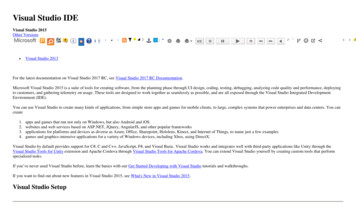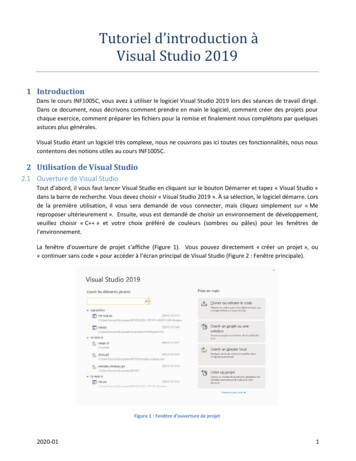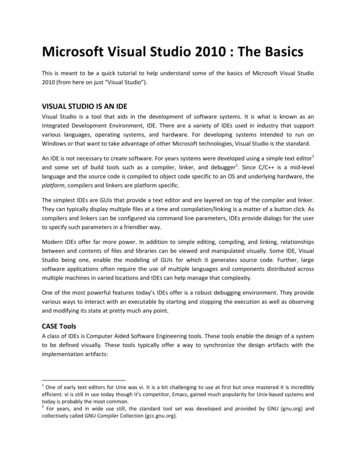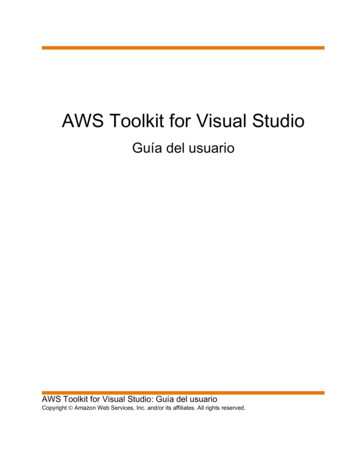
Transcription
Visual Studio#visualstudio
Table of ContentsAbout1Chapter 1: Getting started with Visual Studio2Remarks2Versions2Examples3Installation or SetupChapter 2: Adding an extensionExamples455Adding an extension to visual studio using a VSIX file5Adding an extension to visual studio from Visual Studio Gallery5Chapter 3: Code Contracts9Remarks9Examples9Standard precondition9Precondition that throws a specific Exception9Pre and postconditions9Chapter 4: Connecting your visual studio project to GithubExamplesPublishing your project to a github repository removing sensitive dataChapter 5: Visual Studio toolsExamples1010101818Code Lens18Snippets18Intoduction18Using the code181. Header192. Snippet202.1 Imports202.2 Declarations212.3 References22
2.4 Code22Import Snippet into Visual Studio25Point of intrest27Override merge/compare tools27Entity Framework28Credits29
AboutYou can share this PDF with anyone you feel could benefit from it, downloaded the latest versionfrom: visual-studioIt is an unofficial and free Visual Studio ebook created for educational purposes. All the content isextracted from Stack Overflow Documentation, which is written by many hardworking individuals atStack Overflow. It is neither affiliated with Stack Overflow nor official Visual Studio.The content is released under Creative Commons BY-SA, and the list of contributors to eachchapter are provided in the credits section at the end of this book. Images may be copyright oftheir respective owners unless otherwise specified. All trademarks and registered trademarks arethe property of their respective company owners.Use the content presented in this book at your own risk; it is not guaranteed to be correct noraccurate, please send your feedback and corrections to info@zzzprojects.comhttps://riptutorial.com/1
Chapter 1: Getting started with Visual StudioRemarksVisual Studio is an Integrated Development Environment (IDE) from Microsoft. It enables thedeveloper to work project orientated with various types of projects, including Windows Forms,Console Applications, Office Plug-Ins, and Windows Universal Apps.The IDE supports various programming languages, the most common being Visual C#, VisualBasic, Visual F#, and Visual C .There are several editions of Visual Studio: Community (free), Express (free), Professional,Enterprise, and Ultimate (However, not all are available for all orted .NETFramework 998-0601.NET 2002Rainier7.01.02002-0213.NET 2003Everett7.11.12003-04242005Whidbey8.02.0, 3.02005-11072008Orcas9.02.0, 3.0, 3.52007-11192010Dev10/Rosario10.02.0 - 4.02010-04122012Dev1111.02.0 - 4.5.22012-09122013Dev1212.02.0 - 4.5.22013-10172013.1 (Updatehttps://riptutorial.com/2014-012
VersionCodenameVersionnumberSupported .NETFramework versionsDate1)202013.2 (Update2)2014-05122013.3 (Update3)2014-08042013.4 (Update4)2014-11122013.5 (Update5)2015-07202015Dev1414.02.0 - 4.62015-07202015.1 (Update1)2015-11302015.2 (Update2)2016-03302015.3 (Update3)2016-0627"15" PreviewDev1515.02.0 - 4.6.2; Core 1.02016-0330"15" Preview 22016-0510"15" Preview 32016-0707"15" Preview 42016-0822"15" Preview 52016-10052017Dev1515.0 - 15.23.5 - 4.7; Core 1.0 1.12017-0307Exampleshttps://riptutorial.com/3
Installation or SetupVisual Studio can be downloaded and installed for free in Comunity edition from the Microsoft siteand can be also found in different versions. Just click on the Download button and run theexecutable, then follow the instructions.Read Getting started with Visual Studio online: .com/4
Chapter 2: Adding an extensionExamplesAdding an extension to visual studio using a VSIX fileIf you have a vsix file, you can install it by running the file.1. Get the vsix file (this is the extension installer)2. Run the file.3. In the window that opens, confirm the installation.Adding an extension to visual studio from Visual Studio GalleryIn Visual studio go to Tools Extensions and updates.In the window that opens go to onlineSelect Visual Studio GalleryYou can search for an extension on the search box at the upper right cornerSelect the extension you want to addClick on download.Once download is complete, click on the Install button on the window that opened.In order to use the extension, you might be requested to restart visual studiohttps://riptutorial.com/5
https://riptutorial.com/6
https://riptutorial.com/7
Read Adding an extension online: dding-anextensionhttps://riptutorial.com/8
Chapter 3: Code ContractsRemarksIn order to fully benefit from Code Contracts you need to install the extension for Visual Studio.There's also a Code Contracts User Manual.ExamplesStandard preconditionusing System.Diagnostics.Contracts;public int DivideNumbers(int numerator, int denominator){Contract.Requires(denominator ! 0);return numerator / denominator;}Precondition that throws a specific Exceptionusing System.Diagnostics.Contracts;public int DivideNumbers(int numerator, int denominator){Contract.Requires ArgumentOutOfRangeException (denominator ! 0);return numerator / denominator;}Pre and postconditionsusing System.Diagnostics.Contracts;public int IncrementByRandomAmount(int input){Contract.Requires ArgumentNullException (input ! null); // Don't allow null parameter.Contract.Requires ArgumentOutOfRangeException (input int.MaxValue); // We can't doanything if we're given int.MaxValue.Contract.Ensures(Contract.Result int () input); // Return value will be greater thaninput value.Random rnd new Random();input rnd.Next(1, 13); // Creates a number between 1 and 12 and adds it to input.return input;}Read Code Contracts online: ode-contractshttps://riptutorial.com/9
Chapter 4: Connecting your visual studioproject to GithubExamplesPublishing your project to a github repository removing sensitive datathe steps in this example will use the following project structure as a demonstrationand we intend to export it to the "GHTuts" Repository [Note that the Repo doesn't exist yet ongithub] but leave the "SensitiveProject" without publish as it contains some passwords, keys, etc.1. First of all we make sure the source control plug in is set to "Git" in "Tools Options Plugin Selection"https://riptutorial.com/10
2. If you can't see the "Team Explorer" tab, view it in visual studio like this1. Go to your local solution folder and create a new file called ".gitignore.txt" [Note] this step isonly important if you have some sensitive information in your project,otherwise, let visualstudio create it for you2. Now open the ".gitignore.txt" file and paste this in it, this is a template for ignoring commonvisual studio files (check the links below)## Ignore Visual Studio temporary files, build results, and## files generated by popular Visual Studio add-ons.# User-specific files*.suo*.user*.userosscache*.sln.docstates# User-specific files (MonoDevelop/Xamarin Studio)*.userprefs# Build ses/x64/x86/bld/[Bb]in/https://riptutorial.com/11
[Oo]bj/[Ll]og/# Visual Studio 2015 cache/options directory.vs/# Uncomment if you have tasks that create the project's static files in wwwroot#wwwroot/# MSTest test Results[Tt]est[Rr]esult*/[Bb]uild[Ll]og.*# NUNIT*.VisualState.xmlTestResult.xml# Build Results of an ATL Project[Dd]ebugPS/[Rr]eleasePS/dlldata.c# facts/* i.c* p.c* .tlb*.tli*.tlh*.tmp*.tmp c# Chutzpah Test filesChutzpah*# Visual C cache riptutorial.com/12
*.cachefile*.VC.db*.VC.VC.opendb# Visual Studio profiler*.psess*.vsp*.vspx*.sap# TFS 2012 Local Workspace tf/# Guidance Automation Toolkit*.gpState# ReSharper is a .NET coding er# JustCode is a .NET coding add-in.JustCode# TeamCity is a build add-inTeamCity*# DotCover is a Code Coverage Tool*.dotCover# NCrunchNCrunch *.*crunch*.local.xmlnCrunchTemp *# MightyMoose*.mm.*AutoTest.Net/# Web workbench (sass).sass-cache/# Installshield output folder[Ee]xpress/# DocProject is a documentation generator ml2DocProject/Help/html# Click-Once directorypublish/# Publish Web rial.com/13
# TODO: Comment the next line if you want to checkin your web deploy settings# but database connection strings (with potential passwords) will be unencrypted*.pubxml*.publishproj# Microsoft Azure Web App publish settings. Comment the next line if you want to# checkin your Azure Web App publish settings, but sensitive information contained# in these scripts will be unencryptedPublishScripts/# NuGet Packages*.nupkg# The packages folder can be ignored because of Package Restore**/packages/*# except build/, which is used as an MSBuild target.!**/packages/build/# Uncomment if necessary however generally it will be regenerated when needed#!**/packages/repositories.config# NuGet v3's project.json files produces more ignoreable files*.nuget.props*.nuget.targets# Microsoft Azure Build Outputcsx/*.build.csdef# Microsoft Azure Emulatorecf/rcf/# Windows Store app package directories and ciation.xmlpkginfo.txt# Visual Studio cache files# files ending in .cache can be ignored*.[Cc]ache# but keep track of directories ending in .cache!*.[Cc]ache/# OthersClientBin/ ** de modules/orleans.codegen.cs# Since there are multiple workflows, uncomment next line to ignore bower components# uecomment-104372622)#bower components/# RIA/Silverlight projectsGenerated Code/# Backup & report files from converting an old project filehttps://riptutorial.com/14
# to a newer Visual Studio version. Backup files are not needed,# because we have git ;-)UpgradeReport Files/Backup*/UpgradeLog*.XMLUpgradeLog*.htm# SQL Server files*.mdf*.ldf# Business Intelligence projects*.rdl.data*.bim.layout*.bim *.settings# Microsoft FakesFakesAssemblies/# GhostDoc plugin setting file*.GhostDoc.xml# Node.js Tools for Visual Studio.ntvs analysis.dat# Visual Studio 6 build log*.plg# Visual Studio 6 workspace options file*.opt# Visual Studio LightSwitch build rver/ModelManifest.xmlPvt Extensions# Paket dependency manager.paket/paket.exepaket-files/# FAKE - F# Make.fake/# JetBrains Rider.idea/*.sln.iml3. Now add your sensitive project folder to the ".gitignore.txt" file at any line that doesn't contain#, so just add it at the very end, and it should look something like thishttps://riptutorial.com/15
4. Right click on the solution and choose "Add Solution to Source Control."[Note] it might askyou to save the solution before you continue5. Now you have a "LOCAL" git Repo on your pc , which VS will read from,but without a githubRepo, and you will see a small blue lock icon next to each file in the solution that was addedto git and a red circle at the ignored project[Note]for more information about .gitignore file, check these links https://help.github.com/articles/ignoring-files/ rial.com/16
7. Go to the "Team Explorer" tab and then "Sync"8. Now we create a repo from vs to github like this, press the "Get Started" button9. Now fill in your information in github for the new Repo, then click "Publish"10. Now when we go to github we see our local repo got published to github without oursensitive project [Note]the url of the repo will look something like thishttps://github.com/ user name / repo name Read Connecting your visual studio project to Github online: ://riptutorial.com/17
Chapter 5: Visual Studio toolsExamplesCode LensCode lens is a simple way to know what happens with the code. Here you could find an image withthe number of references of a method or class.If you can't see the code lens please see this question: Missing CodeLens references count in VS2015 Community editionSnippetsIntoductionSince Visual Studio 2005 can you make Intellisense Code Snippets. This allow you to generatesome code just by typing one keyword and press two times the tab key.Using the codeThe XML code you need for make an Intellisense Code Snippet stands below: ?xml version "1.0" encoding "utf-8"? CodeSnippets xmlns ppet" CodeSnippet Format "1.0.0" !-- format attribute is required -- Header !-- 1 -- Title /Title Author /Author Shortcut /Shortcut https://riptutorial.com/18
Description /Description Keywords Keyword abc Keyword Keyword def Keyword /keywords /Header Snippet !-- 2 -- Imports !-- 2.1 -- Import Namespace System /Namespace /Import /Imports Declarations !-- 2.2 -- Literal Editable "true/false" !-- 2.2.1 -- ID example /ID Type System.String /Type ToolTip A tip you can show /ToolTip Default default value /Default Function /Function !-- 2.2.2 -- /Literal Object !-- 2.2.1 -- ID example /ID Type System.String /Type ToolTip A tip you can show /ToolTip Default default value /Default Function /Function !-- 2.2.2 -- /Object /Declarations References !-- 2.3 -- Reference Assembly System.Data.dll /Assembly /Reference /References Code Language "" !-- 2.4 -- ![CDATA[ !-- your code here if you use literals use dollar chars]] /Code -- /Snippet /CodeSnippet /CodeSnippets In the snippet tag, you have two required tags named Header and Snippet. You can find moreinformation in next headings. The number near the name are correspondents with the numbers inthe code above.There can be zero or more CodeSnippet elements added into the CodeSnippets element.1. Headerhttps://riptutorial.com/19
In the Header-tag, you can place some specific information about the snippet and what he does.The important tags you can use inside this tag are:ElementDescriptionTitleThe title of the snippet. This attribute is required.AuthorThe author of the snippet.ShortcutIs the shortcut, you can use for generating the code. Note that this can onlycontain letters and numbers and must begin with a letter.Note: Remember also to give the snippet a good and unique name andshortcut. Otherwise, it will give problems when you import the snippet intoVisual Studio.DescriptionGives more information about the snippet if you need that.HelpUrlA url for a help page on the internet.KeywordsGroups one or more keyword elements.Groups SnippetType elements. This element contain a text value and must beone of the following values. Snippet types are merged with a forward slash.SnippetTypes SurroundsWith:Allows the code snippet to be placed around a selectedpiece of code. Expansion: Allows the code snippet to be inserted at the cursor. Refactoring: Specifies that the code snippet is used during Visual C#refactoring. Refactoring cannot be used in custom code snippets.Source list: msdn.microsoft.comSource table (but edits): msdn.microsoft.com2. SnippetIn the snippet tag, you can use three different tags. This can be: ImportsDeclarationsCode (required)ReferencesThese are explained below.2.1 Importshttps://riptutorial.com/20
contain the needed namespaces you need for the code. Use the import-tag inside this tagand here you can place the needed namespaces each with the Namespace-tag.Imports2.2 Declarationscan be used for declaring some literals or objects into your code in the Code-tag. Thechildren are literals and objects.Declarations2.2.1 Literals and objectsLiterals and objects define the literals and objects of the code snippet that you can edit.Functionality are literals and objects are the same, but it has an additional type constraint.The Literal and object-tag can contain next children: ID:The ID of the literal (required)Type: The type of that object including namespace and class (required by objects)ToolTip: Gives a tipDefault: A default value of that object (required)FunctionsIn the snippets, there are some predefined literals. They are listed below:LiteralDetails end Marks the location to place the cursor after the code snippet is inserted.Represents text selected in the document that is to be inserted into the snippetwhen it is invoked. Example, If you have:A selected is an object that I like. selected and the word was car selected when you invoked the template, you would get:A car is an object that I like.2.2.2 FunctionsFunctions in the Literal- or Object-tag means that you can use a function for generating codedepending on another element. There are three functions that I s(EnumerationLiteral)Generates a switch statement and a set of casestatements for the members of the enumerationspecified by the EnumerationLiteral parameter.The EnumerationLiteral parameter must be eitherVisual C#and VisualJ#1https://riptutorial.com/21
FunctionDescriptionLanguagea reference to an enumeration literal or anenumeration type.1ClassName()Returns the name of the class that contains theinserted snippet.Visual C#and VisualJ#1SimpleTypeName(TypeName)Reduces the TypeName parameter to its simplestform in the context in which the snippet wasinvoked.Visual C#only available in Visual Studio 2005.Source table: msdn.microsoft.comAttributes for the Literal and Object ElementsThe Literal and Object tags can have some optional es whether or not you can edit the literal after the code snippetis inserted. The default value of this attribute is true.BooleanSource table: msdn.microsoft.com2.3 ReferencesGroups reference elements that contains information about assembly references for the codesnippet. This can contain next elements: Assembly: Contains the name of the assembly by the code snippet (required) Url: Contains a website that gives more information about the assembly2.4 CodeCode is the code you will generate between ![CDATA[ and ]] . Place the ID of your literal betweendollar chars and Visual Studio will ask you for change these default value if the declarations arefilled in. Here, you've an example for C# and VB for the shortcut propfull. !-- . Other code . -- Declarations Literal Id variablename /Id Default myproperty /Default /Literal https://riptutorial.com/22
Literal Id propertytype /Id Default int /Default /Literal Literal Id propertyname /Id Default myproperty /Default /Literal /Declarations Code Language "CSharp" ![CDATA[private propertyvalue variablename ;public propertyvalue propertyname {get { return variablename ; }set { Variablename Value; }}]] /Code !-- . Other code . -- Declarations Literal Id variablename /Id Default myproperty /Default /Literal Literal Id propertytype /Id Default int /Default /Literal Literal Id propertyname /Id Default myproperty /Default /Literal /Declarations Code Language "VB" ![CDATA[Private variablename As propertyvalue Public Property propertyname As propertyvalue GetReturn variablename End GetSet (ByVal value As propertyvalue ) variablename valueEnd SetEnd Property]] /Code !-- . Other code . -- In the required Language attribute, you can define your language where you are making thehttps://riptutorial.com/23
snippet. You can find the languages you can use in the next table.LanguageKeywordAvailable in next versionsVisual C#CSharp2005, 2010, 2012 and laterVisual BasicVB2005, 2010, 2012 and laterXMLXML2005, 2010, 2012 and laterVisual J#VJSharp2005, 2012 and laterC CPP2012 and laterJavaScriptJavaScript2012 and laterJScriptJScript2012 and laterSQLSQL2012 and laterHTMLHTML2012 and laterCSSCSS2012 and laterXAMLXAML2012 and laterOther optional attributes are:AttributeDescriptionDelimiterSpecifies the delimiter used to describe literals and objects in the code. Bydefault, the delimiter is .KindSpecifies the kind of code that the snippet contains and, therefore, the location atwhich a code snippet must be inserted for the code snippet to compile.The valid values for the kind variable are:ValueDescriptionmethodbodySpecifies that the code snippet is a method body, and therefore, must beinserted inside a method declaration.methoddeclSpecifies that the code snippet is a method, and therefore, must be insertedinside a class or module.type declSpecifies that the code snippet is a type, and therefore, must be inserted insidea class, module, or namespace.https://riptutorial.com/24
ValueDescriptionfileSpecifies that the snippet is a full code file. These code snippets can be insertedalone into a code file, or inside a namespace.anySpecifies that the snippet can be inserted anywhere. This tag is used for codesnippets that are context-independent, such as comments.Source tables: msdn.microsoft.comImport Snippet into Visual Studio1. Save the XML code and give it the extension .snippet.2. You can add the new made snippet into Visual Studio by pressing Control K, Control B orgo to "Tools" "Code Snippets Manager.". This open next window:https://riptutorial.com/25
3. Choose the language into the combo box for which language you've made the snippet. clickon "Import." and choose the file you've made.4. Click on "Finish". If the file name already has been used, Visual Studio go ask to overridethe existing file. You've three options: Overwrite: Overwrites the file. You can use this option if you will edit an old snippet. Rename: Goes to rename the file to an unique name. Skip: Cancels the import. Renames the file to a unique name.You could also add a new location with all the snippets you've made by clicking on the "Add."button on the first window and select the folder in the "select folder window". The advantage isnow when a new valid snippet is added in that folder, you can use this directly in Visual Studio.Note: Test after importing your snippet for errors, so you don't have any problems when you usehttps://riptutorial.com/26
the snippet. You can always remove or overwrite the snippet if there is an error.Point of intrestYou can also see the documentation on MSDN for more information.Override merge/compare toolsGot to Tools Options Source Control Visual Studio Team Foundation Serverclick on the Configure User Tools:You can add separate overrides for 'Compare' and 'Merge' operations. Click on Add and select theoperation you want to override. You'd need to type the path to the tool you use, and the exactarguments your tool expects. For example to use BeyondCompare, add the following Arguments "%1 %2 /title1 %6 /title2 %7":https://riptutorial.com/27
To Merge with BeyondCompare use the Arguments "%1 %2 %3 %4 /title1 %6 /title2 %7/title3 %8 /title4 %9"In a 2006 blog post MS employee James Manning surveyed the arguments as expected byvarious tools: WinDiff, DiffDoc, WinMerge, Beyond Compare, KDiff3, Araxis, Compare It!,SourceGear DiffMerge, TortoiseMerge and Visual SlickEdit. The post is a good starting point, butbe sure to check the up to date documentation of your tool.It is highly recommended not to use for merge tools that are incapable of 3-way merges (e.g.,WinMerge 2.x).Entity FrameworkEntity Framework (EF) is an object-relational mapper that enables .NET developers towork with relational data using domain-specific objects. It eliminates the need for mostof the data-access code that developers usually need to write.Entity Framework allows you to create a model by writing code or using boxes andlines in the EF Designer. Both of these approaches can be used to target an existingdatabase or create a new database.Source and more information: Entity Framework documentationRead Visual Studio tools online: isual-studio-toolshttps://riptutorial.com/28
CreditsS.NoChaptersContributors1Getting started withVisual StudioAlmir Vuk, Avi Turner, Cody Gray, Community, Derpcode,Fruchtzwerg, H. Pauwelyn, meJustAndrew, Misaz, Nikita,Richard Banks2Adding an extensionAvi Turner3Code ContractsDisk Crasher4Connecting yourvisual studio projectto Githubbigworld125Visual Studio toolsdove, H. Pauwelyn, Ofek Shilonhttps://riptutorial.com/29
Adding an extension to visual studio using a VSIX file If you have a vsix file, you can install it by running the file. 1. Get the vsix file (this is the extension installer) 2. Run the file. 3. In the window that opens, confirm the installation. Adding an extension to visual studio from Visual Studio Gallery In Visual studio









